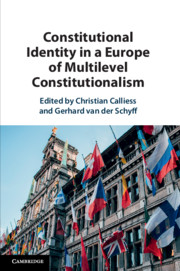Book contents
- Constitutional Identity in a Europe of Multilevel Constitutionalism
- Constitutional Identity in a Europe of Multilevel Constitutionalism
- Copyright page
- Contents
- Contributors
- Acknowledgements
- Part I Constitutional Identity Introduced and Its EU Law Dimension
- Part II Constitutional Identity and Its Member State Law Dimension
- 3 Constitutional Identity in Austria
- 4 Constitutional Identity in Belgium
- 5 Constitutional Identity in the Czech Republic
- 6 Constitutional Identity in Denmark
- 7 Constitutional Identity in France
- 8 Constitutional Identity in Germany
- 9 Constitutional Identity in Ireland
- 10 Constitutional Identity in Italy
- 11 Constitutional Identity in the Netherlands
- 12 Constitutional Identity in Poland
- 13 Constitutional Identity in Spain
- 14 Constitutional Identity in the United Kingdom
- Part III Comparative Constitutional Identity and Multilevel Constitutionalism
- Index
6 - Constitutional Identity in Denmark
Extracting Constitutional Identity in the Context of a Restrained Supreme Court and a Strong Legislature
from Part II - Constitutional Identity and Its Member State Law Dimension
Published online by Cambridge University Press: 03 October 2019
- Constitutional Identity in a Europe of Multilevel Constitutionalism
- Constitutional Identity in a Europe of Multilevel Constitutionalism
- Copyright page
- Contents
- Contributors
- Acknowledgements
- Part I Constitutional Identity Introduced and Its EU Law Dimension
- Part II Constitutional Identity and Its Member State Law Dimension
- 3 Constitutional Identity in Austria
- 4 Constitutional Identity in Belgium
- 5 Constitutional Identity in the Czech Republic
- 6 Constitutional Identity in Denmark
- 7 Constitutional Identity in France
- 8 Constitutional Identity in Germany
- 9 Constitutional Identity in Ireland
- 10 Constitutional Identity in Italy
- 11 Constitutional Identity in the Netherlands
- 12 Constitutional Identity in Poland
- 13 Constitutional Identity in Spain
- 14 Constitutional Identity in the United Kingdom
- Part III Comparative Constitutional Identity and Multilevel Constitutionalism
- Index
Summary
Traditionally, Danish case law, academic literature, and other sources do not refer directly to ‘constitutional identity’. However, this absence of the term constitutional identity does not mean that Denmark has none. What it does mean is that it must be extracted from an interpretation of the Constitution, case law, and other sources. Seen in light of the different models of national separation of power in the EU Member States, this chapter challenges the common assumption that constitutional courts and supreme courts are the definers of national constitutional identity in relation to Article 4(2) TEU. In some Member States, the courts are very active in defining constitutional identity, but in others with strong parliaments and more reluctant courts, this is not the case. In order to secure equality between the Member States, we will have to accept that institutions other than courts can be the definers of constitutional identity, depending on the national model for separation of powers.
Keywords
- Type
- Chapter
- Information
- Publisher: Cambridge University PressPrint publication year: 2019
- 1
- Cited by

